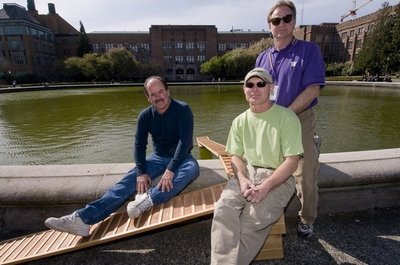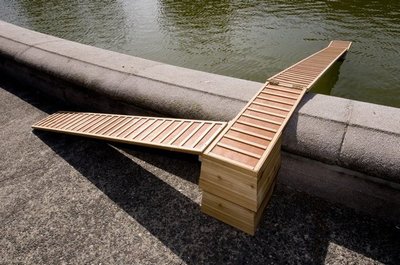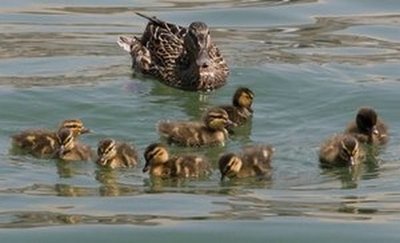April 1, 2010
Time once again to make way for — you know who (quack!)
The ducklings are coming — maybe — and all is in readiness. Right now, in hidden places around campus, mother ducks may be sitting on eggs that will eventually hatch, after which Mom needs to get her brood to water.
More often than not, that water turns out to be Frosh Pond, a body of water not ideally suited to ducklings. For one thing, it has a wall surrounding it that is too high for ducklings to jump over, and they’re not yet ready to fly, as their mother can. Moreover, if they do get in the water (thanks to some well-meaning human), they can’t get out again. That’s where Facilities Services staffers come in. They’ve built a ramp — new and improved since last year, according to Jon Hooper, manager of the Central Maintenance Zone — that will allow ducklings to get into and out of the pond. The ramp will be placed in the pond if ducklings appear there.
Of course, the University would prefer the ducklings not get into the pond. “It really isn’t the best place for them,” said Charles Easterberg, the University’s public health adviser. “There isn’t much in the way of food there, and they’re very vulnerable to predators.”
Ducklings have also been known to swim into an overflow chamber that holds excess water in heavy rain, and then they can’t get out. Facilities Services staff have now screened this opening, Hooper said.
Staffers who see ducklings on campus without their mother should leave them alone, Easterberg said. The mother is probably nearby and will take care of them. In fact, he said humans should only interfere when the duck family is in a location they can’t escape, such as an elevated area that the mother can fly out of but the ducklings can’t. In that case, call his office and report the duck family’s location. Easterberg or someone on his staff will call USDA Wildlife Services, with whom they have an agreement to remove the ducks to open water. That agreement is new since last year, Easterberg said.
If the Wildlife Services person is unable to come, Easterberg will use a laborious procedure to remove the ducks. He places the ducklings in a box and tilts the box so that the mother can see them. She will then follow as he takes the duckling to open water.
In spite of anyone’s preferences, ducklings do make it into the pond nearly every year, however. And once there, they become stars, drawing people to the area to watch them and take pictures. Last year, Julia Parrish, a waterfowl expert who heads the Program on the Environment, arranged to have a sign made telling people to leave the ducks alone and not move the ramp. That sign will appear again this year.
So, once again, the campus is ready to host duck families. Vicky Palm, director of grants and contracts in the Arts & Sciences Dean’s Office, is happy that people are thinking ahead. Several years ago, she and her colleagues were surprised to find a family of ducks nesting in one of the thigh-high planters outside the Communication Building. The ducklings couldn’t get down, and when Palm called asking for assistance, she was told to leave the ducks alone.
That duck family eventually made it into the pond, but Palm and about 20 other staffers have an e-mail list informally called “Friends of Ducks” through which they try to be aware of what’s going on with the ducks on campus. This year Palm and a few other representatives of the group met with Easterberg and Hooper and were told about the plans.
“I’m glad Charles [Easterberg] called the meeting,” Palm said. “The ducklings are very cute, people do look at them and it behooves the University to try to do something to try to help them.”



